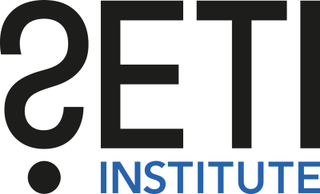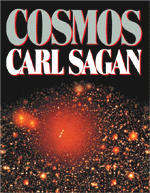
Ann Druyan is an Emmy and Peabody Award-winning American writer, producer, and director specializing in the communication of science. She co-wrote the 1980 PBS documentary series Cosmos, hosted by Carl Sagan, whom she married in 1981. She is the creator, producer, and writer of the 2014 sequel, Cosmos: A Spacetime Odyssey and its upcoming new season, Cosmos: Possible Worlds. She is credited with directing episodes of both series as well.

Carl Edward Sagan was an American astronomer, cosmologist, astrophysicist, astrobiologist, author, science popularizer, and science communicator in astronomy and other natural sciences. He is best known as a science popularizer and communicator. His best known scientific contribution is research on extraterrestrial life, including experimental demonstration of the production of amino acids from basic chemicals by radiation. Sagan assembled the first physical messages sent into space: the Pioneer plaque and the Voyager Golden Record, universal messages that could potentially be understood by any extraterrestrial intelligence that might find them. Sagan argued the now accepted hypothesis that the high surface temperatures of Venus can be attributed to and calculated using the greenhouse effect.

Cosmos: A Personal Voyage is a thirteen-part television series written by Carl Sagan, Ann Druyan, and Steven Soter, with Sagan as presenter. It was executive-produced by Adrian Malone, produced by David Kennard, Geoffrey Haines-Stiles, and Gregory Andorfer, and directed by the producers, David Oyster, Richard Wells, Tom Weidlinger, and others. It covers a wide range of scientific subjects, including the origin of life and a perspective of our place in the universe.

"Ancient astronauts" refers to the pseudoscientific idea that intelligent extraterrestrial beings visited Earth and made contact with humans in antiquity and prehistoric times. Proponents suggest that this contact influenced the development of modern cultures, technologies, and religions, and even human biology. A common position is that deities from most, if not all, religions are extraterrestrial in origin, and that advanced technologies brought to Earth by ancient astronauts were interpreted as evidence of divine status by early humans.

Contact is a 1997 American science fiction drama film directed by Robert Zemeckis. It is a film adaptation of Carl Sagan's 1985 novel of the same name; Sagan and his wife Ann Druyan wrote the story outline for the film. Jodie Foster portrays the film's protagonist, Dr. Eleanor "Ellie" Arroway, a SETI scientist who finds strong evidence of extraterrestrial life and is chosen to make first contact. The film also stars Matthew McConaughey, James Woods, Tom Skerritt, William Fichtner, John Hurt, Angela Bassett, Rob Lowe, Jake Busey and David Morse.

The Demon-Haunted World: Science as a Candle in the Dark is a 1995 book by astrophysicist Carl Sagan, in which the author aims to explain the scientific method to laypeople, and to encourage people to learn critical and skeptical thinking. He explains methods to help distinguish between ideas that are considered valid science and those that can be considered pseudoscience. Sagan states that when new ideas are offered for consideration, they should be tested by means of skeptical thinking and should stand up to rigorous questioning.

The SETI Institute is a not-for-profit research organization whose mission is to explore, understand, and explain the origin and nature of life in the universe, and to apply the knowledge gained to inspire and guide present and future generations. It aims for discovery and for sharing knowledge as scientific ambassadors to the public, the press, and the government. SETI stands for the "search for extraterrestrial intelligence". The Institute consists of three primary centers: The Carl Sagan Center, devoted to the study of life in the universe, the Center for Education, focused on astronomy, astrobiology and space science for students and educators, and the Center for Public Outreach, producing "Big Picture Science," the Institute's general science radio show and podcast, and "SETI Talks" weekly colloquium series.
Dorion Sagan is an American author, essayist, fiction writer, and theorist from Madison, Wisconsin. He has written and co-authored books on culture, evolution, and the history and philosophy of science, including Cosmic Apprentice,Cracking the Aging Code, and Lynn Margulis: The Life and Legacy of a Scientific Rebel. His book Into the Cool, co-authored with Eric D. Schneider, is about the relationship between non-equilibrium thermodynamics and life.

Cosmos is a 1980 popular science book by astronomer and Pulitzer Prize-winning author Carl Sagan. Its 13 illustrated chapters, corresponding to the 13 episodes of the Cosmos TV series, which the book was co-developed with and intended to complement, explore the mutual development of science and civilization. One of Sagan's main purposes for the book and television series was to explain complex scientific ideas to anyone interested in learning. Sagan also believed the television was one of the greatest teaching tools ever invented, so he wished to capitalize on his chance to educate the world. Spurred in part by the popularity of the TV series, Cosmos spent 50 weeks on the Publishers Weekly best-sellers list and 70 weeks on the New York Times Best Seller list to become the best-selling science book ever published at the time. In 1981, it received the Hugo Award for Best Non-Fiction Book. The book's unprecedented success ushered in a dramatic increase in visibility for science-themed literature. The success of the book also jumpstarted Sagan's literary career. The sequel to Cosmos is Pale Blue Dot: A Vision of the Human Future in Space (1994).

Russell's teapot is an analogy, formulated by the philosopher Bertrand Russell (1872–1970), to illustrate that the philosophic burden of proof lies upon a person making unfalsifiable claims, rather than shifting the burden of disproof to others.

Billions and Billions: Thoughts on Life and Death at the Brink of the Millennium is a 1997 book by the American astronomer and science popularizer Carl Sagan. The last book written by Sagan before his death in 1996, it was published by Random House.

Broca's Brain: Reflections on the Romance of Science is a 1979 book by the astrophysicist Carl Sagan. Its chapters were originally articles published between 1974 and 1979 in various magazines, including The Atlantic Monthly, The New Republic, Physics Today, Playboy and Scientific American. In the introduction, Sagan wrote:
As long as there have been human beings, we have posed the deep and fundamental questions...If we don't destroy ourselves, most of us will be around for the answers... By far the most exciting, satisfying and exhilarating time to be alive is the time in which we pass from ignorance to knowledge on these fundamental issues.
The Carl Sagan Award for Public Understanding of Science is an award presented by the Council of Scientific Society Presidents (CSSP) to individuals who have become “concurrently accomplished as researchers and/or educators, and as widely recognized magnifiers of the public's understanding of science.” The award was first presented in 1993 to astronomer, Carl Sagan (1934–1996), who is also the award's namesake.

Pale Blue Dot: A Vision of the Human Future in Space is a 1994 book by Carl Sagan. It is the sequel to Cosmos and was inspired by the famous 1990 Pale Blue Dot photograph, for which Sagan provides a poignant description. In this book, Sagan mixes philosophy about the human place in the universe with a description of the current knowledge about the Solar System. He also details a human vision for the future.

The Portable Atheist: Essential Readings for the Nonbeliever (2007) is an anthology edited by Christopher Hitchens. Hitchens wrote introductions to each article he compiled for the book. The main introduction is centered on an unbeliever's point of view, what he is constantly told, "and the errors incurred by religion, since the pre-history of our species, in identifying not just the wrong explanation but the wrong culprit in episodes of nightmarish ignorance and calamity".
The Symphony of Science is a music project created by Washington-based electronic musician John D. Boswell. The project seeks to "spread scientific knowledge and philosophy through musical remixes." Boswell uses pitch-corrected audio and video samples from television programs featuring popular educators and scientists. The audio and video clips are mixed into digital mashups and scored with Boswell's original compositions. Two of Boswell's music videos, "A Glorious Dawn" and "We are All Connected", feature appearances from Carl Sagan, Richard Feynman, Neil deGrasse Tyson, Bill Nye, and Stephen Hawking. The audio and video is sampled from popular science television shows including Cosmos, The Universe, The Eyes of Nye, The Elegant Universe, and Stephen Hawking's Universe.

Comet is a 1985 popular-science book by Carl Sagan and Ann Druyan. The authors describe the scientific nature of comets, as well as their varying roles and perceptions throughout history. The evolution of human understanding of comets is also detailed, and thinkers and astronomers such as Edmond Halley, Immanuel Kant, and William Huggins are discussed.

The Voyager Golden Record contains 116 images plus a calibration image and a variety of natural sounds, such as those made by surf, wind, and thunder, and animal sounds, including the songs of birds, whales and dolphins. The record, which is carried on both the Voyager 1 and Voyager 2 spacecraft, additionally features musical selections from different cultures and eras, spoken greetings in fifty-nine languages, other human sounds, like footsteps and laughter, and printed messages from President Jimmy Carter and U.N. Secretary-General Kurt Waldheim. The items were selected for NASA by a committee chaired by Carl Sagan of Cornell University.
The Carl Sagan Prize for Science Popularization is an annual $5,000 award presented in honor of the late scientist Carl Sagan by Wonderfest, the San Francisco Bay Area Beacon of Science, to a scientist who has "contributed mightily to the public understanding and appreciation of science."

God, the Universe and Everything Else is a 1988 documentary featuring Stephen Hawking, Arthur C. Clarke and Carl Sagan, and moderated by Magnus Magnusson. They discuss the Big Bang theory, God and the possibility of extraterrestrial life.

















